Physical Address
304 North Cardinal St.
Dorchester Center, MA 02124
Dynamic ultrasound is the key examination for assessing the groin or anterior abdominal wall pain. Dynamic components of the examination include Valsalva and compression maneuvers and scanning in both supine and upright positions. Dynamic sonography enables clinicians to determine hernia type, size, contents, reducibility, and tenderness.
Evaluation of groin pain in athletes is frequently more complex than in nonathletes because of associated tendinosis and osteitis pubis. Adding magnetic resonance imaging to dynamic ultrasound is usually necessary to identify underlying pathologic processes and to decide the best combination of surgical and nonsurgical treatments.
Patients with one hernia frequently have multiple hernias, so in any patient in whom a hernia is sonographically demonstrable, the examination should be continued, looking for other types of ipsilateral and contralateral groin or anterior abdominal hernias. Even when no additional hernias are found, it is important to the surgeon to specifically mention in the report that a complete search of both groin areas was made and no additional hernias were found.
Strangulation is the most dreaded complication of groin hernias. Gray-scale findings of strangulation—hyperechoic fat, isoechoic thickening of the hernia sac, fluid within the sac, and thickening of the walls of bowel loops—are all more sensitive for strangulation than is Doppler ultrasound.
Recurrent pain after herniorrhaphy is a relatively common problem. Dynamic sonography can be helpful in assessing both acute and chronic recurrences of groin pain. Most hernia repairs now use mesh. The key to sonographic identification of recurrent hernias is to assess the edges of the mesh with dynamic maneuvers, because recurrent hernias arise from the edges of the mesh.
Many pathologic processes, both rare and nonspecific, can simulate hernia, but cysts or hydroceles of the processus vaginalis (or canal of Nuck) and round ligament varices are relatively common and have virtually pathognomonic sonographic appearances.
Patients with groin pain may have a variety of conditions including, but not limited to, hip abnormalities, tendonitis, lymphadenopathy, or hernia. Groin pain is a common presenting symptom in adult patients. Herniorrhaphy is the most common surgical procedure in the United States, with more than 800,000 operations performed annually. An estimated 2.3 million inpatient abdominal hernia repairs were performed from 2001 to 2010, of which an estimated 567,000 were performed emergently. A general increase in the rate of total emergent hernias was observed from 16.0 to 19.2 emergent hernia repairs per 100,000 person-years in 2001 and 2010, respectively. The lifetime risk of inguinal hernia requiring repair is high, estimated at 27.2% for men and 2.6% for women. Over 90% of these procedures are performed on male infants younger than 1 year, and thus these numbers do not reflect the incidence in adults.
Large hernias typically cause an obvious lump or bulge and are often diagnosed clinically and infrequently require imaging (except to evaluate the contralateral side preoperatively). On the other hand, patients with hernias with pain but without a lump or bulge are more often referred for diagnostic imaging. Computed tomography (CT) and magnetic resonance imaging (MRI) have been used to identify and describe hernias ( Fig. 13.1 ). However, real-time ultrasound has advantages over other imaging modalities: the ability to scan the patient in both upright and supine positions, to use dynamic maneuvers such as Valsalva and compression, and to document motion in real time ( Fig. 13.2 ). Positioning and dynamic maneuvers affect the operator's ability to diagnose a hernia, alter its size and contents, and evaluate its reducibility. Sonography also enables the user to assess tenderness and clinical importance of a hernia. Thus ultrasound is the imaging modality of choice for assessment of inguinal masses and inguinal pain.
The most common definition of the groin is that it is the region of the ilioinguinal crease at the junction of the abdomen and the thigh and the adjacent areas immediately above and below. In the strictest sense, the only “groin hernias” are inguinal (direct or indirect). However, spigelian and femoral hernias lie so close to the inguinal area that they are considered to be groin hernias as well.
Hernias occur in areas of natural weakness—in areas where vessels penetrate the abdominal wall (femoral and spigelian), where fetal migration of testis, spermatic cord, or round ligament have occurred ( indirect inguinal), and through broad flat tendons called “aponeuroses” ( direct inguinal). Hernias do not occur through the belly of abdominal wall muscles unless they have been surgically incised or otherwise injured.
A high-frequency (≥12 MHz) 50-mm-long transducer is optimal in the majority of patients. In obese patients a lower-frequency transducer may be necessary, usually a 7- to 9-MHz curved array. Use of a 50-mm transducer is important because its larger field of view (FOV) allows better identification of landmarks, especially in patients who have diastasis of aponeuroses. When long-footprint linear transducers are not available, use of a trapezoidal or virtual convex display can be helpful. In some cases, extended-FOV modes can be helpful, particularly in indirect inguinal hernias that extend into the scrotum and long incisional hernias. It is important to be able to store and review video loops in order to capture dynamic events critical to diagnosis. Color and power Doppler ultrasound features show the degree of vascularity associated with inflammatory processes and solid masses and the viability of the herniated bowel loops.
It is important to use correct terminology in reporting the results of a dynamic groin ultrasound examination. In addition to the indication, the report should contain the following elements: (1) the examination name; (2) the specific dynamic components of the examination; (3) the side examined; (4) presence or absence of a hernia; (5) hernia size; (6) hernia contents; (7) reducibility of the hernia; and (8) whether the hernia is tender or nontender. Tenderness is important in determining whether a hernia is more likely to be incidental or clinically significant. This is particularly important when a hernia is found as an incidental finding in a patient who is asymptomatic.
When a hernia has been described in the report, we also report about our search for additional types of ipsilateral or contralateral groin hernias. In a patient with an inguinal hernia, presence of an ipsilateral femoral or spigelian hernia may necessitate use of a larger piece of mesh. Presence of a contralateral hernia may lead to bilateral rather than unilateral repair. Children in particular are often found to have bilateral inguinal hernias.
Hernias are composed of a sac, the parts of which are described as the neck, the body and fundus, and the hernia contents. The inguinal hernia sac consists of peritoneum, which protrudes through the abdominal defect or “hernial orifice” and envelopes the hernial contents. The neck of the sac is situated at the defect. Hernias with a narrow or rigid neck are more likely to obstruct and strangulate. The body is the widest part of the hernia sac, and the fundus is the portion furthest away from the defect. Viscera most likely to enter a hernia sac are those normally situated in the region of the defect and those that are mobile—for example, the omentum and small bowel.
Most sonographically detected hernias do not contain bowel. In fact, most hernias contain only fat ( Fig. 13.3 , Video 13.1). The origin of the fat may be intraperitoneal (mesenteric or omental), preperitoneal, or, in rare instances, both ( Video 13.2). Hernias that contain intraperitoneal fat may contain bowel later and thus may be a greater risk than those that contain only preperitoneal fat. Some hernias contain free fluid of intraperitoneal origin ( Fig. 13.4 ). Hernias that contain bowel are considered higher risk because strangulation may lead to infarction of bowel ( Fig. 13.5 , Video 13.3). Large hernias that are the most likely to contain bowel are easier to detect clinically and less often require sonographic imaging for diagnosis. Hernias can contain small bowel, colon, or appendix. The Amyand hernia is a rare inguinal hernia (about 1% of inguinal hernias, <1% of appendicitis cases) that contains the appendix ( Fig. 13.6 ). Other, much less common hernia contents include ovaries and/or “bladder ears.”
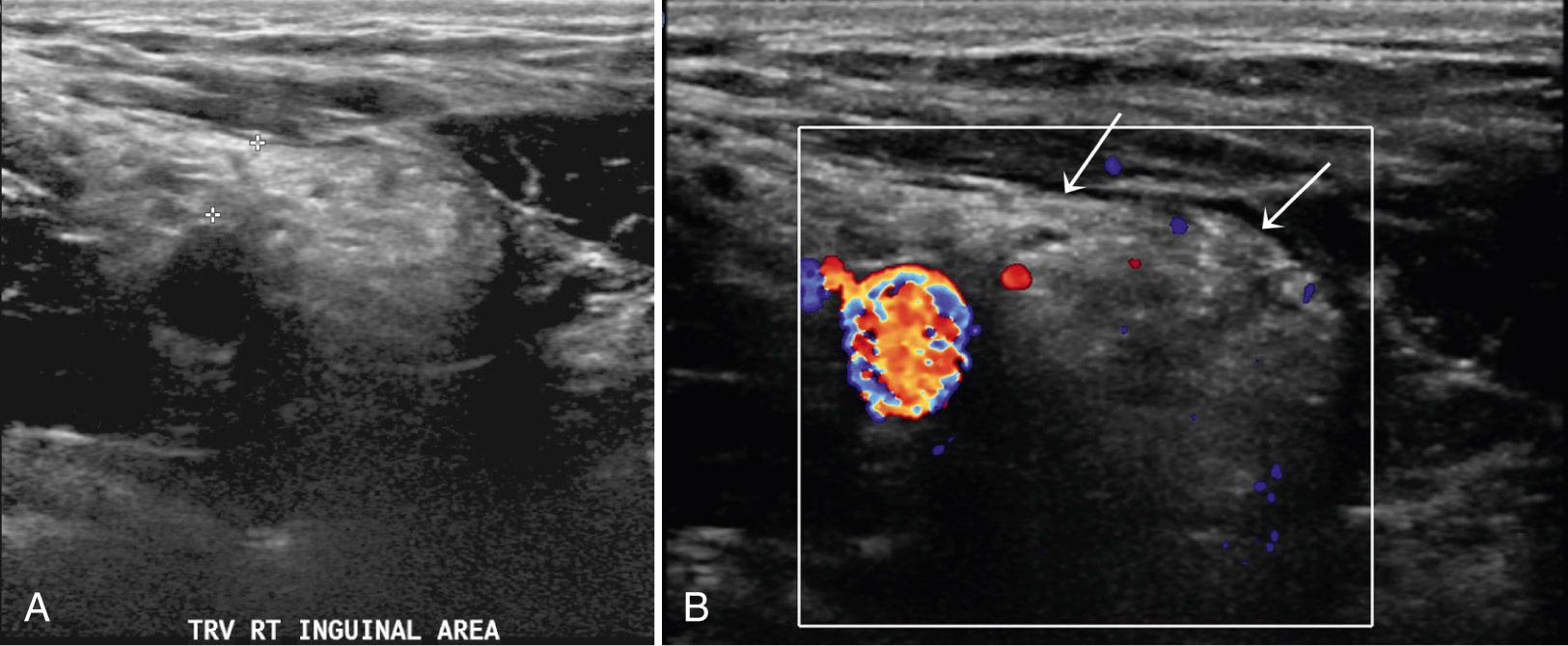

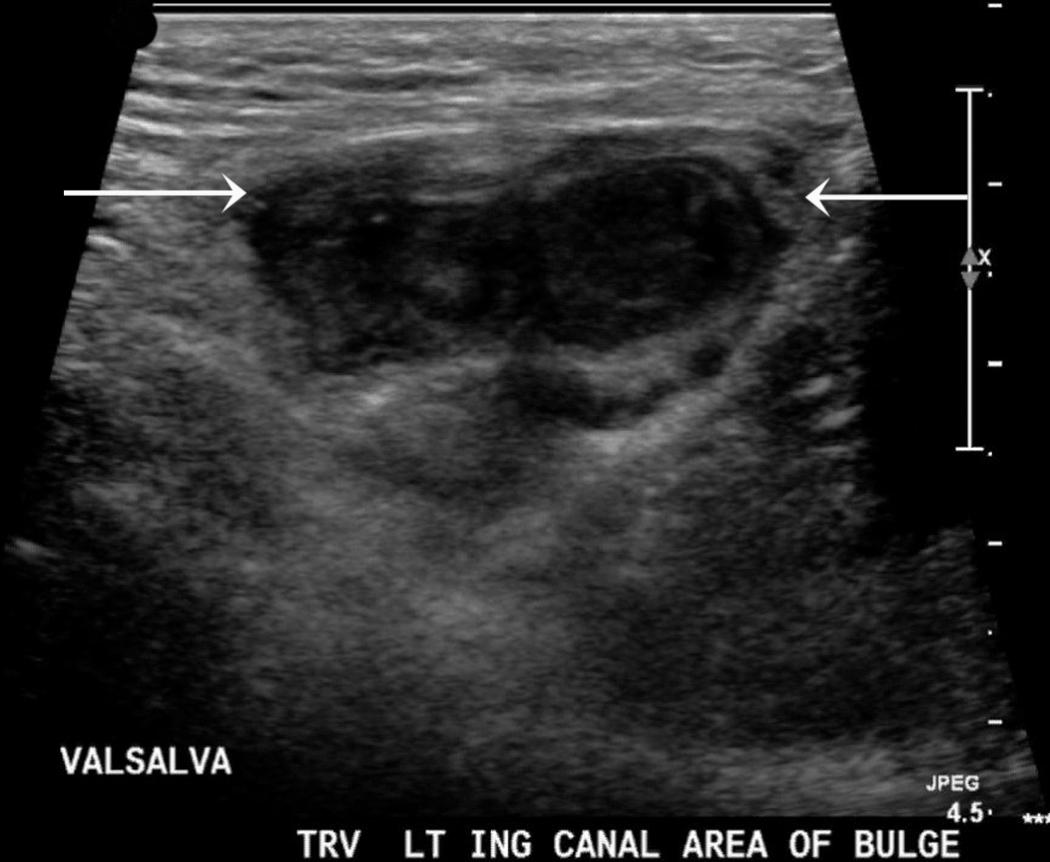
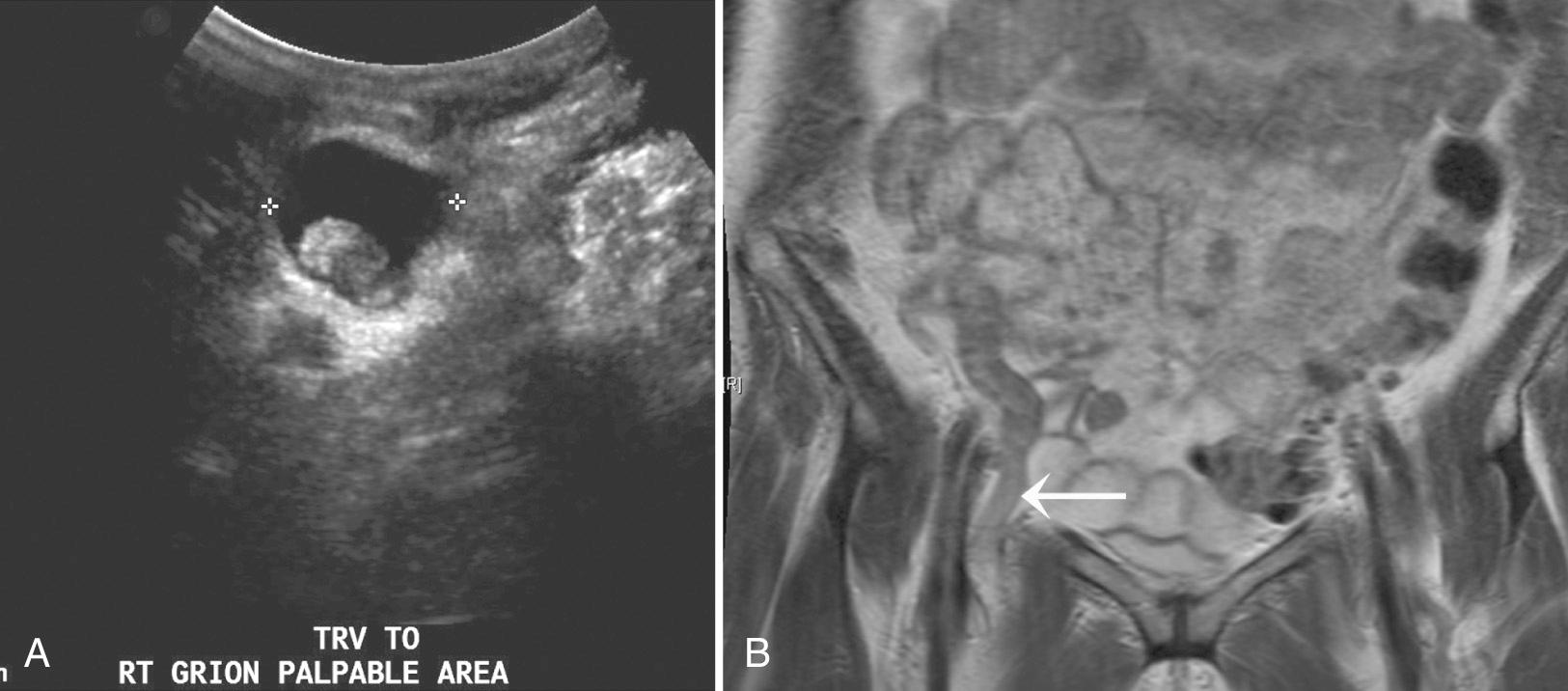
The dynamic maneuvers that are the key to ultrasound's ability to depict and evaluate hernias include watching the region during quiet breathing, the Valsalva maneuver, the compression maneuver, and upright positioning. Dynamic maneuvers are useful because many hernias spontaneously reduce when the patient is supine and breathing quietly. Hernias that contain only fat are almost isoechoic with surrounding tissues and therefore relatively inconspicuous. Watching the groin region during quiet breathing allows for visualization of bowel peristalsis. Assessment with color Doppler allows for assessment of bowel perfusion (implying viability). Dynamic maneuvers can cause the fat within a hernia to move, making the hernia contents more conspicuous. The direction of movement can be helpful, because movement of surrounding tissues is almost always in the anteroposterior (AP) direction, whereas hernia contents often move horizontally or obliquely during compression maneuvers ( Video 13.4). Hernia contents may change with dynamic maneuvers. Finally, reducibility and tenderness can be assessed.
The Valsalva maneuver is most useful when the patient is supine. It forces hernia contents anteriorly, and often horizontally in an inferomedial direction ( Fig. 13.7 ), and at times elicits pain. Some hernias become visible only during the Valsalva maneuver (see Fig. 13.2 ). In other cases, hernia sacs that can be seen in quiet respiration elongate and widen during the Valsalva maneuver. Hernias that appear to contain only fat during quiet respiration may be shown to contain bowel during the Valsalva maneuver ( Video 13.5). In general, hernia sacs should become larger with the Valsalva maneuver. If they stay the same size, this is worrisome for incarceration.
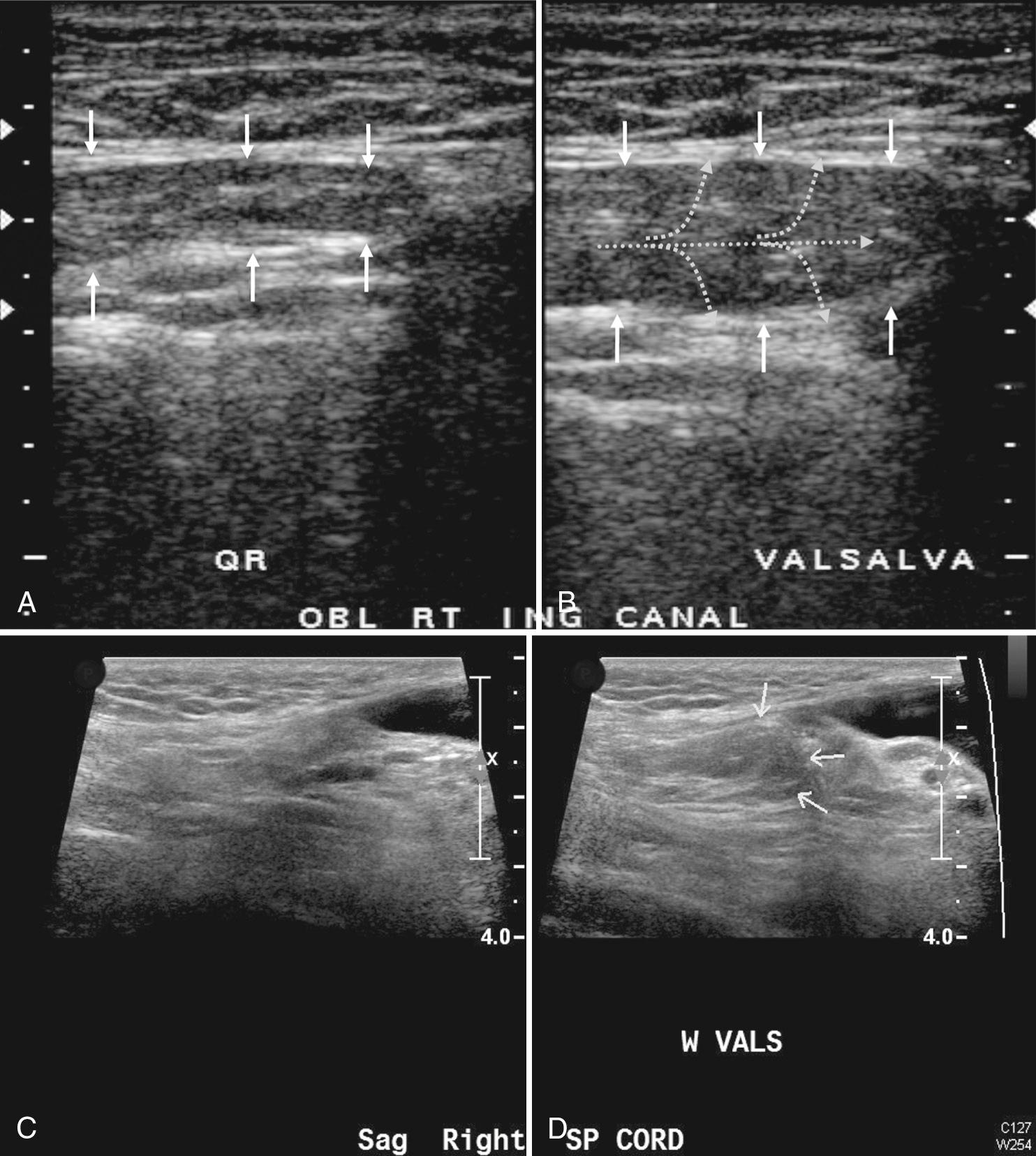
The compression maneuver is essential to assess reducibility and tenderness in patients who have sonographically detectable hernias, regardless of whether the patient is upright or supine. Compression maneuvers are also useful in supine patients in whom the Valsalva maneuver is ineffective. Compression helps assess reducibility of a hernia. Hernias may be completely reducible ( Video 13.6), partially reducible ( Video 13.7), or nonreducible ( Video 13.8). The shape of hernias correlates with reducibility. A hernia with a broad fundus and narrow neck is likely to be nonreducible, whereas a hernia with a broad neck compared with the fundus is more likely to be reducible ( Fig. 13.8 ). Assessing tenderness is very important because dynamic sonography is so sensitive that it can detect many asymptomatic and clinically unimportant hernias. Furthermore, in some patients the pain is caused by other etiologies.
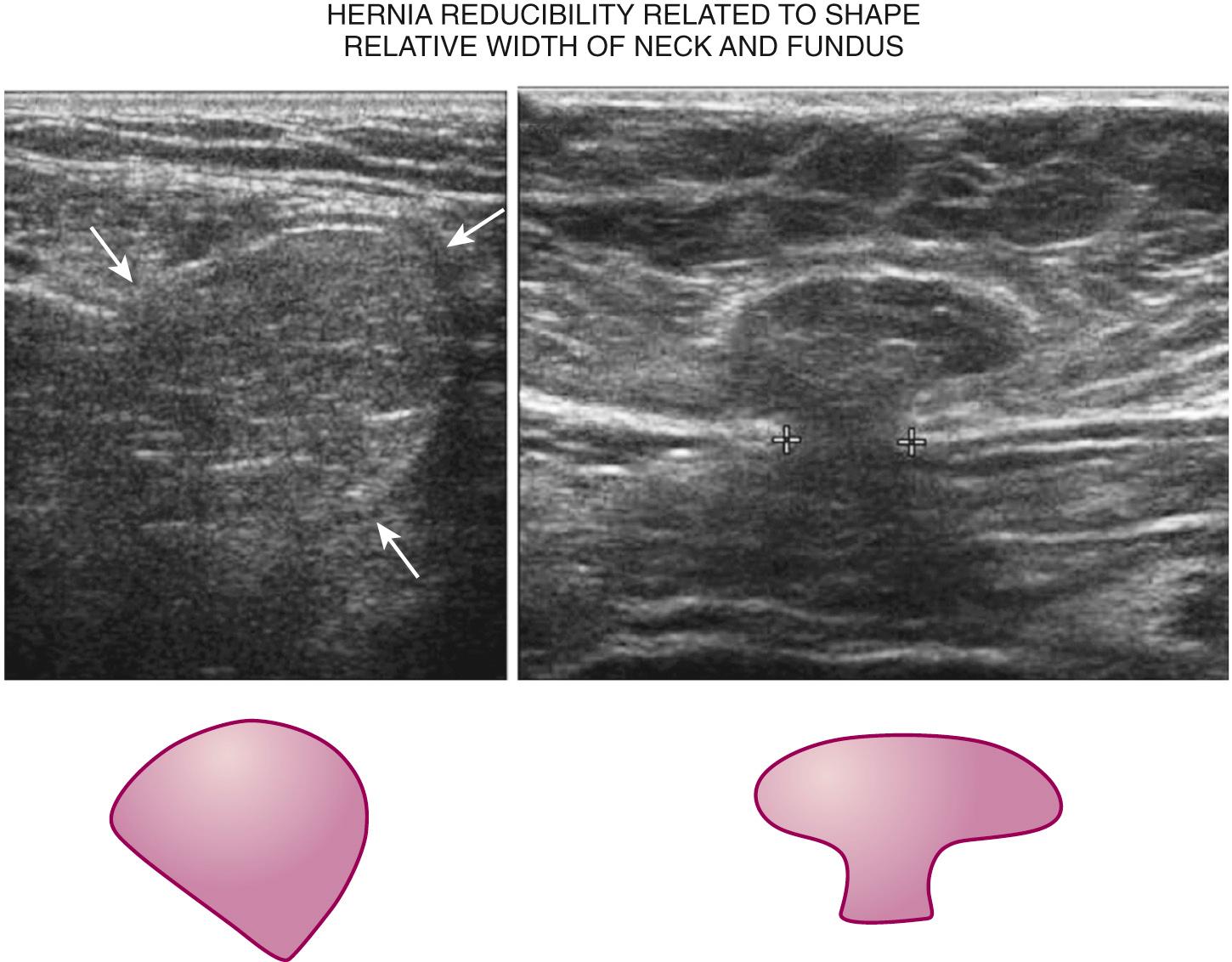
Upright positioning is essential in all patients being sonographically evaluated for groin hernia. Many patients are symptomatic only in the upright position, or they are more symptomatic in the upright position. Fluid is often best demonstrated with the patient in the upright position. It may take minutes for the free fluid to “puddle” in the inferior end of the hernia sac once the patient has been standing. Therefore delayed imaging in the upright position may be helpful in demonstrating peritoneal fluid. Other hernias contain bowel only in the upright position. Some hernias are either only visible in the upright position or are much better demonstrated in the upright position (direct inguinal and femoral). The reducibility of a hernia may vary between supine and upright position, so it is important to assess reducibility in both positions. In most patients, groin hernias are more reducible in the supine than in the upright position, whereas in others the opposite is true.
Ultrasound shows characteristic features of groin hernias that lie above the inguinal ligament. Four types of hernias occur within the broader definition of the groin: indirect inguinal, direct inguinal, spigelian, and femoral. The key landmark in distinguishing among the first three types is the inferior epigastric artery (IEA). This artery arises from the external iliac artery and then courses superomedially, crossing the spigelian fascia and the semilunar line, eventually coursing along the midposterior aspect of the rectus abdominis muscle. The IEA can be identified sonographically in all patients along the midposterior surface of the rectus abdominis muscle at a level about halfway between the umbilicus and pubic symphysis while scanning in a transverse plane ( Fig. 13.9 ). The IEA lies anterior to the peritoneum and thus is never obscured by bowel gas. Once identified in the transverse plane, the IEA can be traced inferiorly and laterally to its origin from the external iliac artery. There are four main types of inguinal hernias ( Table 13.1 , Fig. 13.10 ).

| Hernia Type | Key Findings | Classic Teaching Point |
|---|---|---|
| Indirect inguinal | Herniated structures enter the inguinal canal lateral to the epigastric artery and superior to the inguinal ligament, and extend for a variable distance through the inguinal canal. | Most common groin hernia. Extension into scrotum or labia majora is almost always due to indirect hernia. |
| Direct inguinal | Arise from conjoined tendon, inferior and medial to inferior epigastric artery. Herniation at the inferior aspect of Hesselbach triangle. | Associated with increased abdominal pressure (ascites, obesity, pregnancy), older age, and weak musculature |
| Spigelian | Arise through the spigelian fascia just lateral to where it is penetrated by the internal epigastric artery. The transverse abdominis tendon is always torn. In most cases the internal oblique aponeurosis is also torn. | Sonography shows a complex mass within the anterolateral aspect of the abdominal wall, which may contain fluid- or gas-filled loops of bowel. |
| Femoral | Within the femoral canal, inferior to the inguinal ligament. | This type of hernia has a relatively high association with incarceration. |
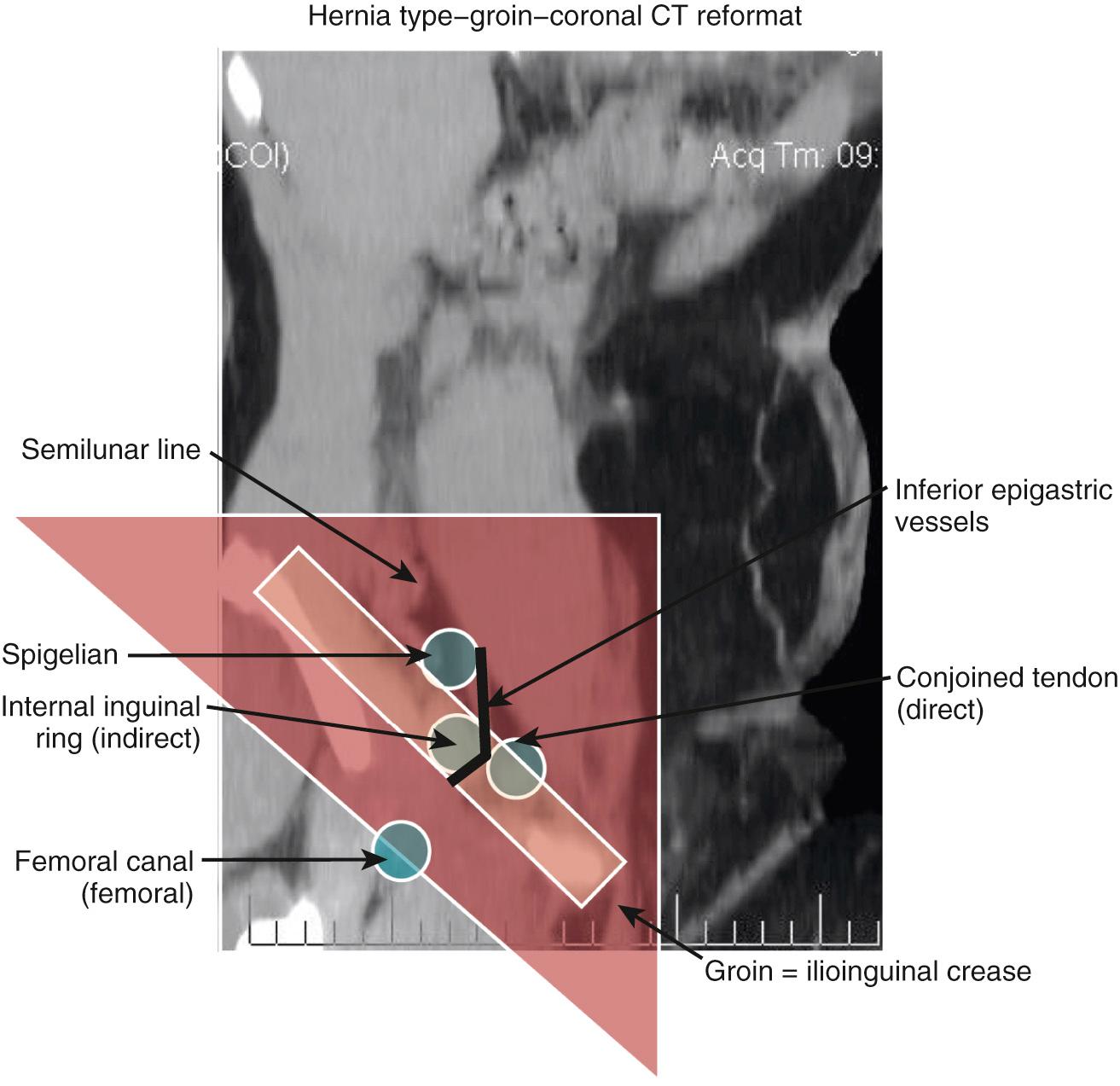
Once the origin of the IEA is identified, the transducer should be rotated into an axis that is parallel to the inguinal ligament, which courses obliquely from superolaterally to inferomedially. The patient should be scanned in long axis parallel to the inguinal ligament and short axis perpendicular to the inguinal ligament.
Inguinal hernias can be classified as direct or indirect. The terms direct and indirect refer to how hernias appear during open surgical repairs. Direct inguinal hernias protrude into the surgically opened inguinal canal “directly” from posteriorly. Indirect inguinal hernias, on the other hand, enter the surgically opened inguinal canal “indirectly” from a superolateral direction after passing through the internal inguinal ring (deep inguinal ring). From a sonographic point of view, “direct” and “indirect” are potentially confusing. It would be less confusing to characterize them as internal inguinal ring (indirect) hernia and nonring (direct) hernia. In a retrospective review of ultrasound examinations of 172 groins in 151 patients, 119 hernias were diagnosed in 107 patients, 60% were indirect inguinal hernias, 19% were direct inguinal hernias, 18% were femoral hernias, and 3% were combined hernias (direct and indirect inguinal hernia). Ninety-two percent contained fat and 30% contained bowel. The overall rates of sensitivity and specificity of ultrasound for diagnosing the presence of groin hernia were 96% and 96% (increasing to 98% and 100% after 2011), and determination of type of hernia was 96% accurate (increasing to 98% after 2011). In a prospective study of 118 patient with a clinical diagnosis of groin hernia, ultrasound was found to be 100% sensitive and specific for the diagnosis of hernia, with distinction between direct and indirect inguinal hernias having sensitivities of 86% and 97%, respectively. Clearly, experience and technique are important factors in achieving high accuracy.
Strength of the transversalis fascia is altered in many patients with inguinal hernias. It is felt that collagen structure and metalloproteinase activity are different in patients with hernias than in the general population, thus putting the transversalis fascia, owing to its location with high pressure with little additional support, at risk for stretching, tearing, and failure. Thus patients with known disorders of tissue strength, including Ehlers-Danlos, Marfan, and Hurler-Hunter syndromes, polycystic kidney disease, and osteogenesis imperfecta, are at increased risk for inguinal hernia.
The characteristic finding of an indirect inguinal hernia is abnormal movement of intraabdominal contents (fat, bowel, or both) through the deep inguinal ring and through the inguinal canal. In the short axis, the indirect inguinal hernia can be seen moving into and out of the plane adjacent to the spermatic cord (in males).
Indirect inguinal hernias are the most common type of groin hernia, being five times more common than direct hernias. In boys, the indirect inguinal hernia is the result of a congenital defect of a patent processus vaginalis. In adults, an indirect hernia is acquired as a result of weakness and dilation of the internal inguinal ring. Indirect hernias represent a persistence of a patent process vaginalis. In males the testis descends from the abdominal cavity into the scrotum, which can result in delayed or incomplete closure of the inguinal canal. Thus indirect inguinal hernias are more common in males. However, delayed or incomplete closure of the canal of Nuck can occur in females. The neck of an indirect inguinal hernia is the segment that lies within the internal inguinal ring, and the fundus lies within the inguinal canal ( Fig. 13.11 ). The neck (internal inguinal ring) lies just superior and lateral to the IEA's origin and tends to be oriented in an AP direction, whereas the fundus (inguinal canal) is oriented horizontally and courses inferiorly and medially, passing superficial to the IEA's origin The fundus of an indirect inguinal hernia lies anterior and lateral to the spermatic cord in males and the round ligament in females ( Fig. 13.12 ). In the short axis, the internal inguinal ring and the neck of the indirect inguinal hernia lie between the external iliac artery along its lateral side and the IEA along its medial side.
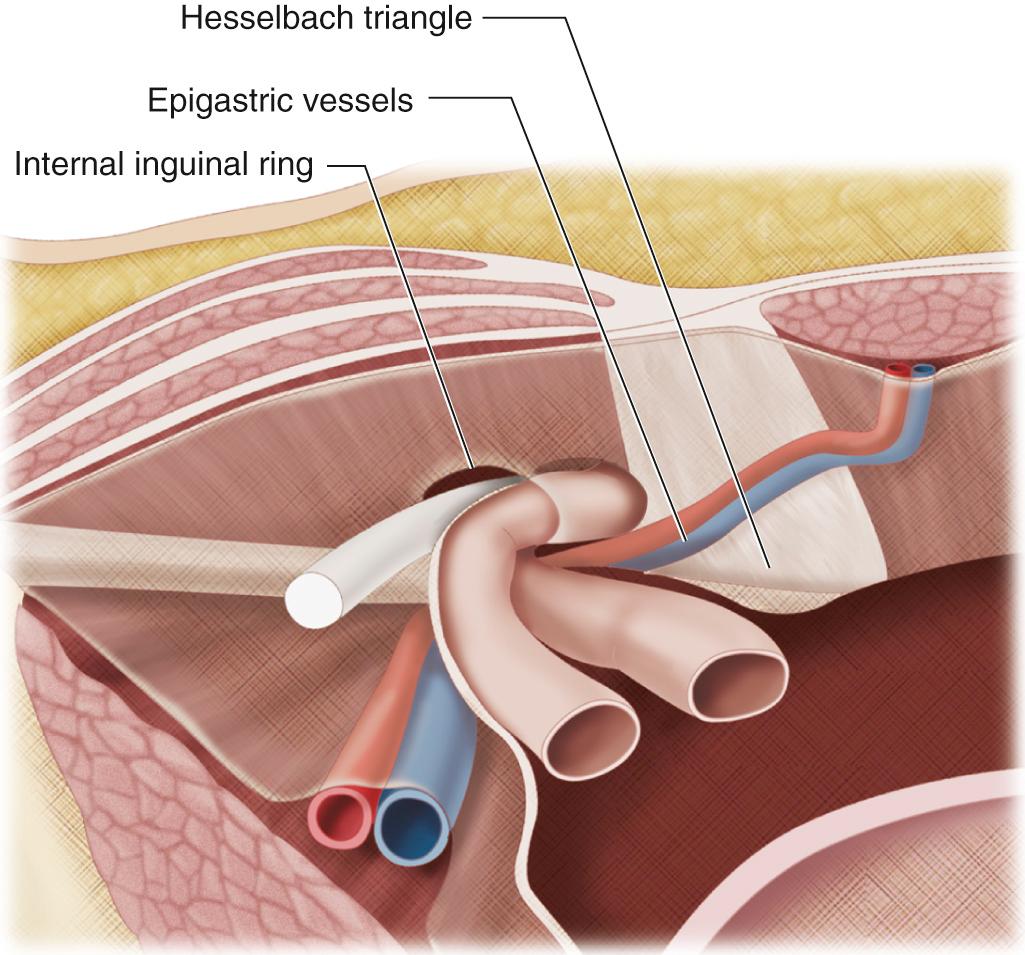
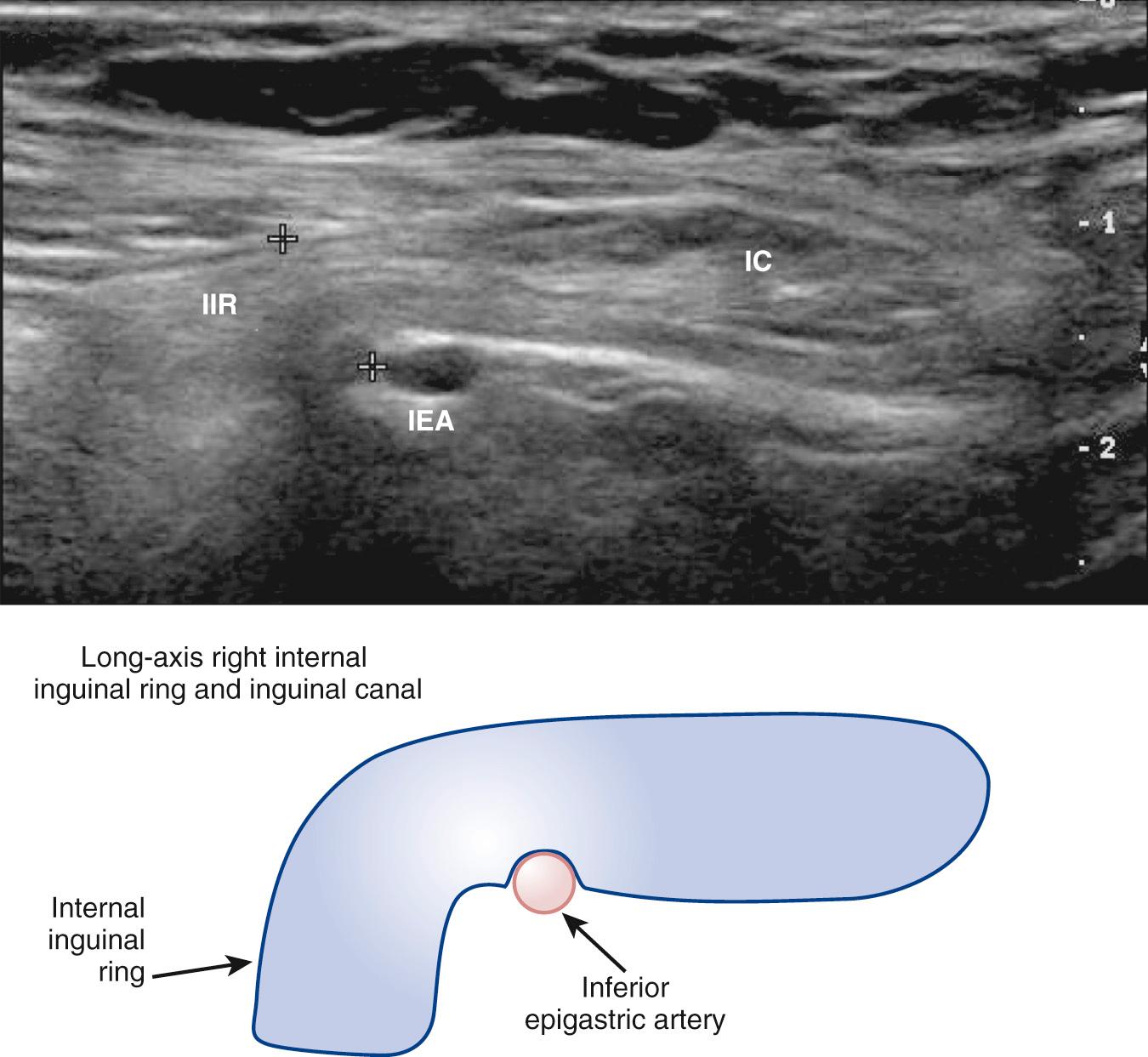
In the long axis, indirect inguinal hernias can have two appearances: sliding and nonsliding. The sliding type of indirect inguinal hernia has a relatively wide neck compared with the fundus, with loss of the angle between the neck and fundus. It is usually reducible and is more likely to contain bowel and other intraperitoneal contents. The nonsliding type has a relatively narrower neck compared with the fundus and maintains the almost 90-degree angle between the neck and fundus ( Fig. 13.13 ). Nonsliding hernias usually contain only properitoneal fat and are nonreducible, and may be misclassified as “spermatic cord lipoma” or “inguinal canal lipoma” at surgery. True spermatic cord lipomas can occur, but are rare. Nonsliding indirect inguinal hernias are more difficult to diagnose sonographically than sliding types because (1) they tend to be smaller; (2) they contain only fat, which is almost isoechoic with surrounding tissues; and (3) their nonreducibility minimizes motion of contents during dynamic maneuvers. In the short axis, the sliding type of direct inguinal hernia can be diagnosed at either the level of the internal inguinal ring or the level of the inguinal canal. However, the nonsliding type can be diagnosed only at the level of the inguinal canal, where it is widest.
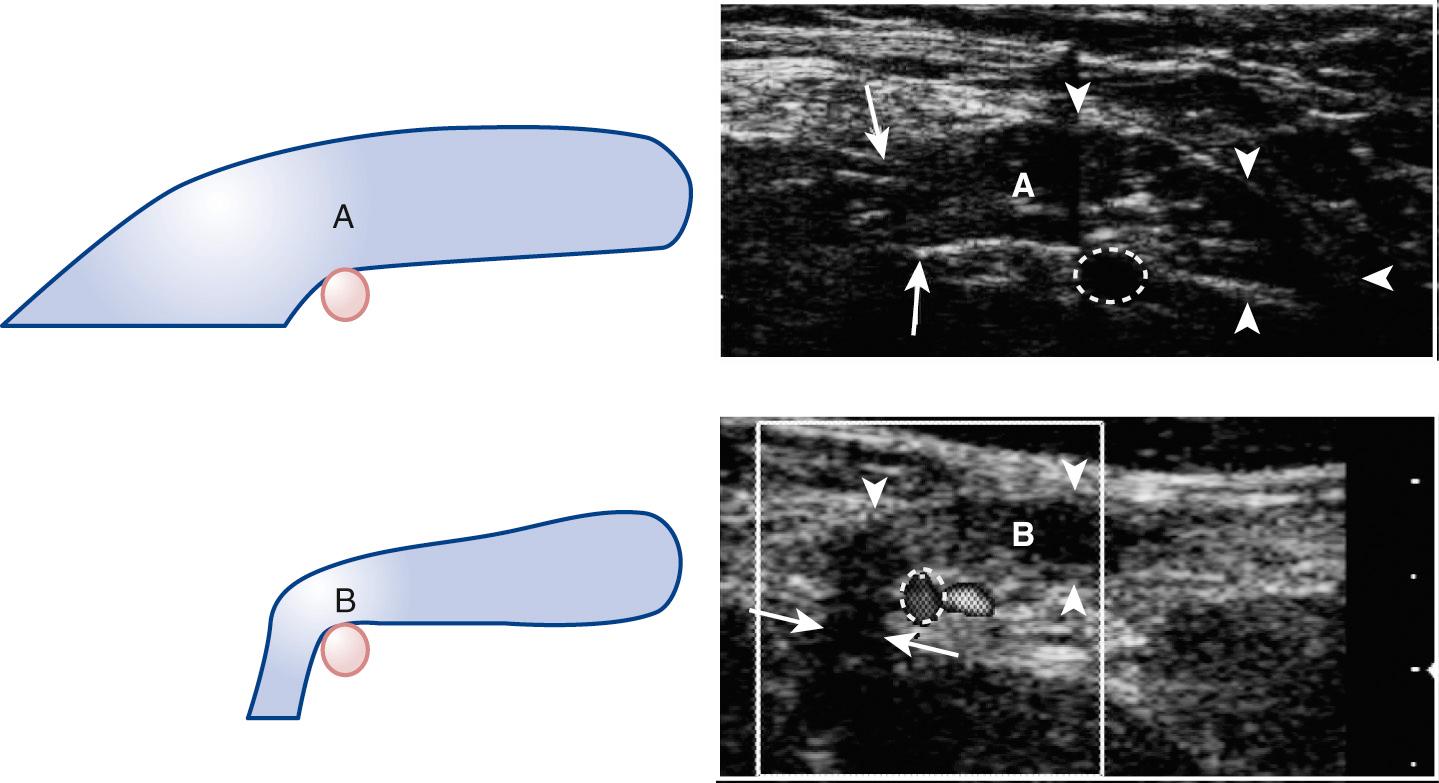
In some cases, it can be difficult to demonstrate the relationship of the hernia neck to the inferior epigastric vessels. In such cases, it is helpful to assess the relationship of the hernia sac to the spermatic cord. In males, indirect inguinal hernias tend to lie along the anterolateral aspect of the spermatic cord, whereas direct inguinal hernia sacs tend to lie posteromedial to the cord ( Fig. 13.14 ). In females, indirect inguinal hernias lie anterior to the round ligament ( Fig. 13.15 ). Large indirect inguinal hernias can flatten and splay the spermatic cord ( Figs. 13.16 and 13.17 ), causing pain that radiates into the scrotum. Indirect inguinal hernias are much more likely than direct inguinal hernias to extend into the scrotum or labium majus ( Fig. 13.18 , Video 13.9).
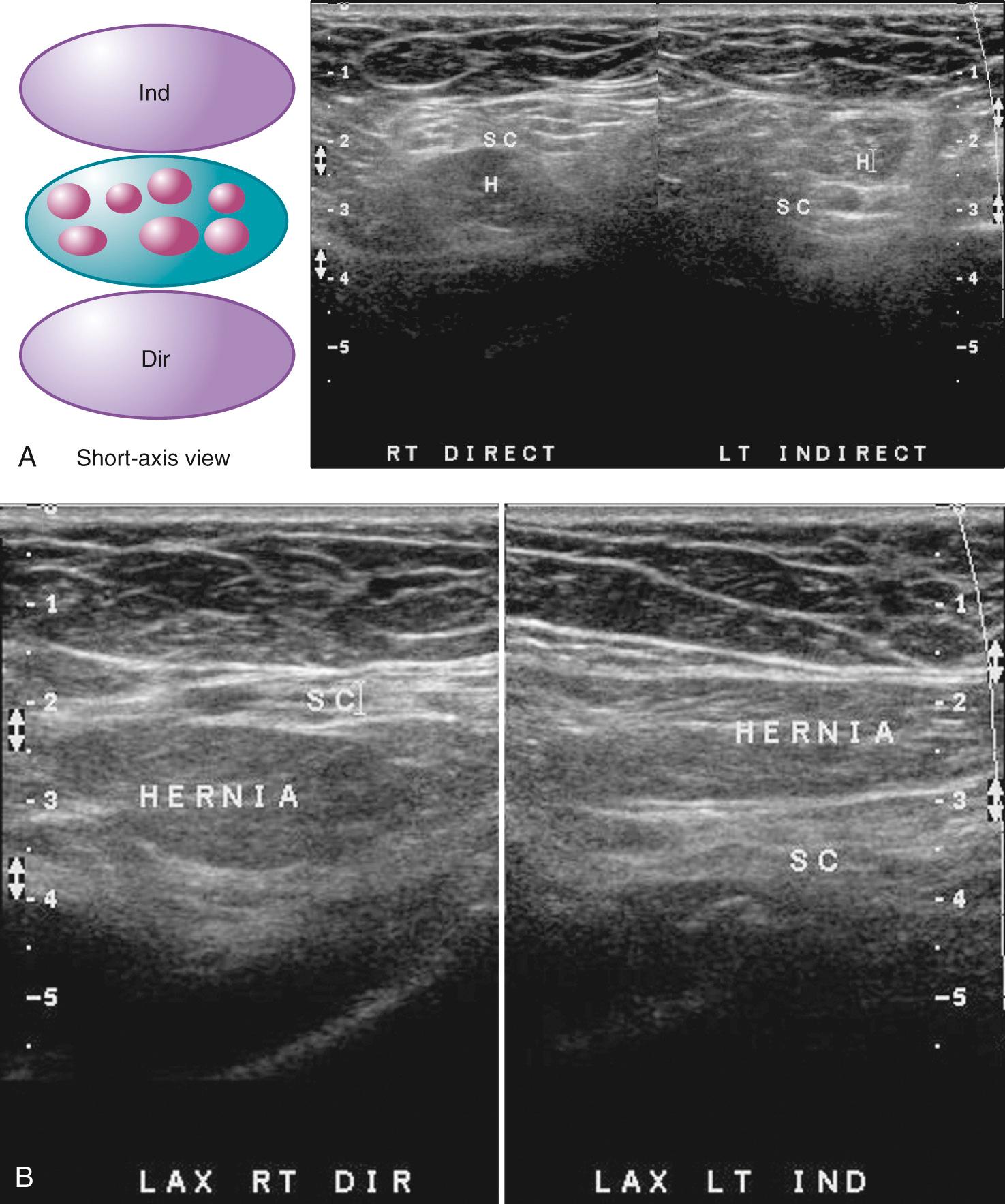
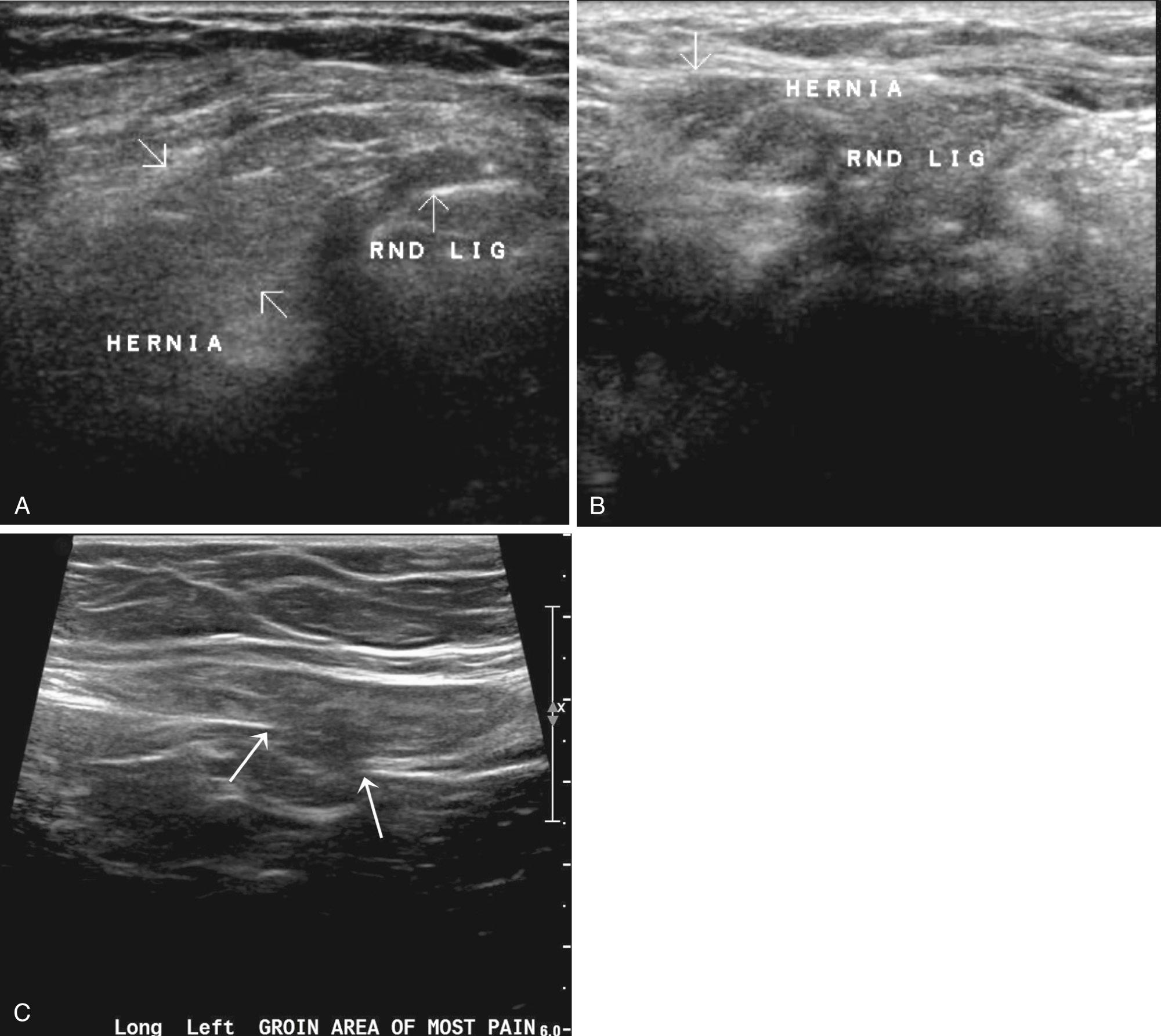
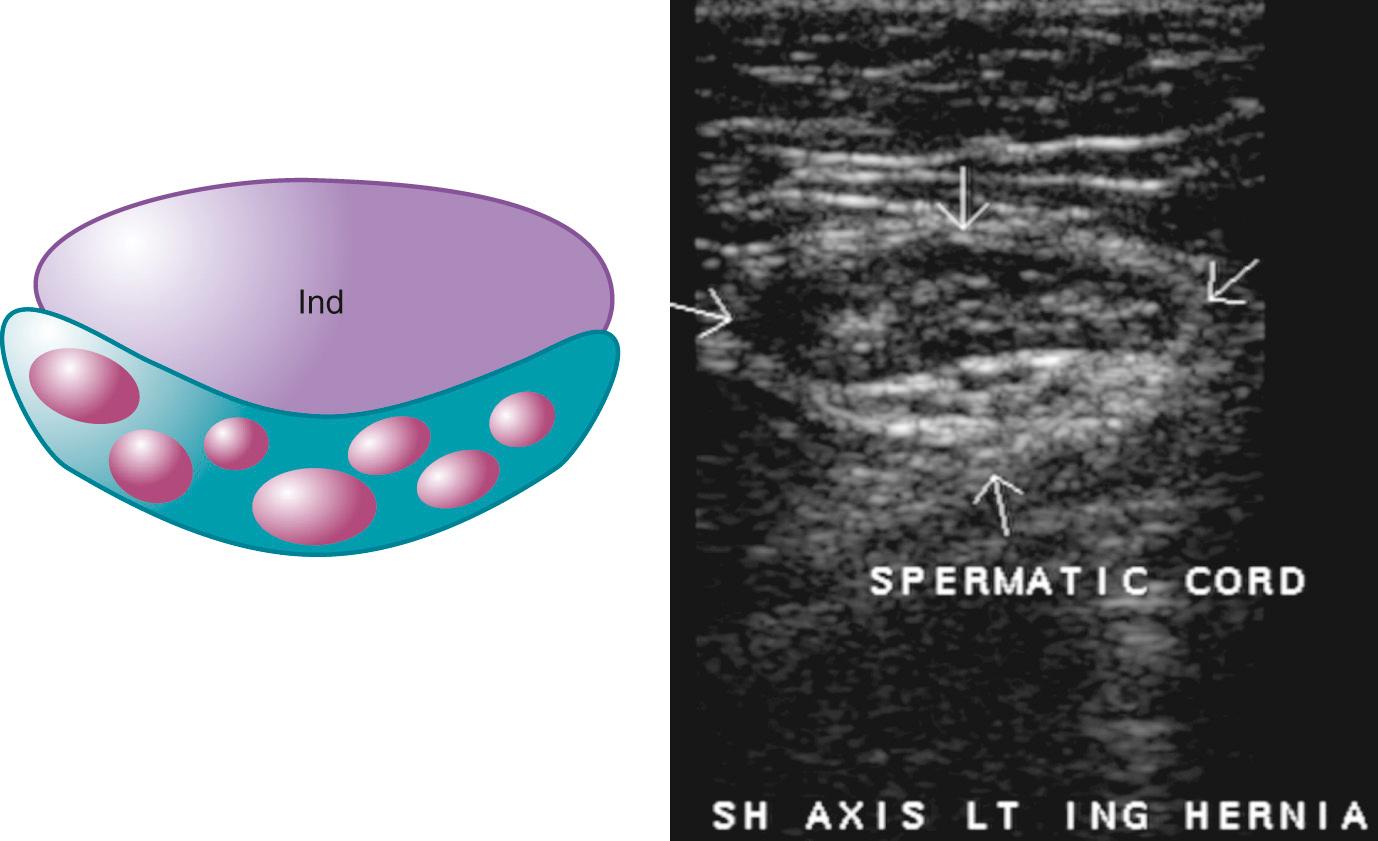
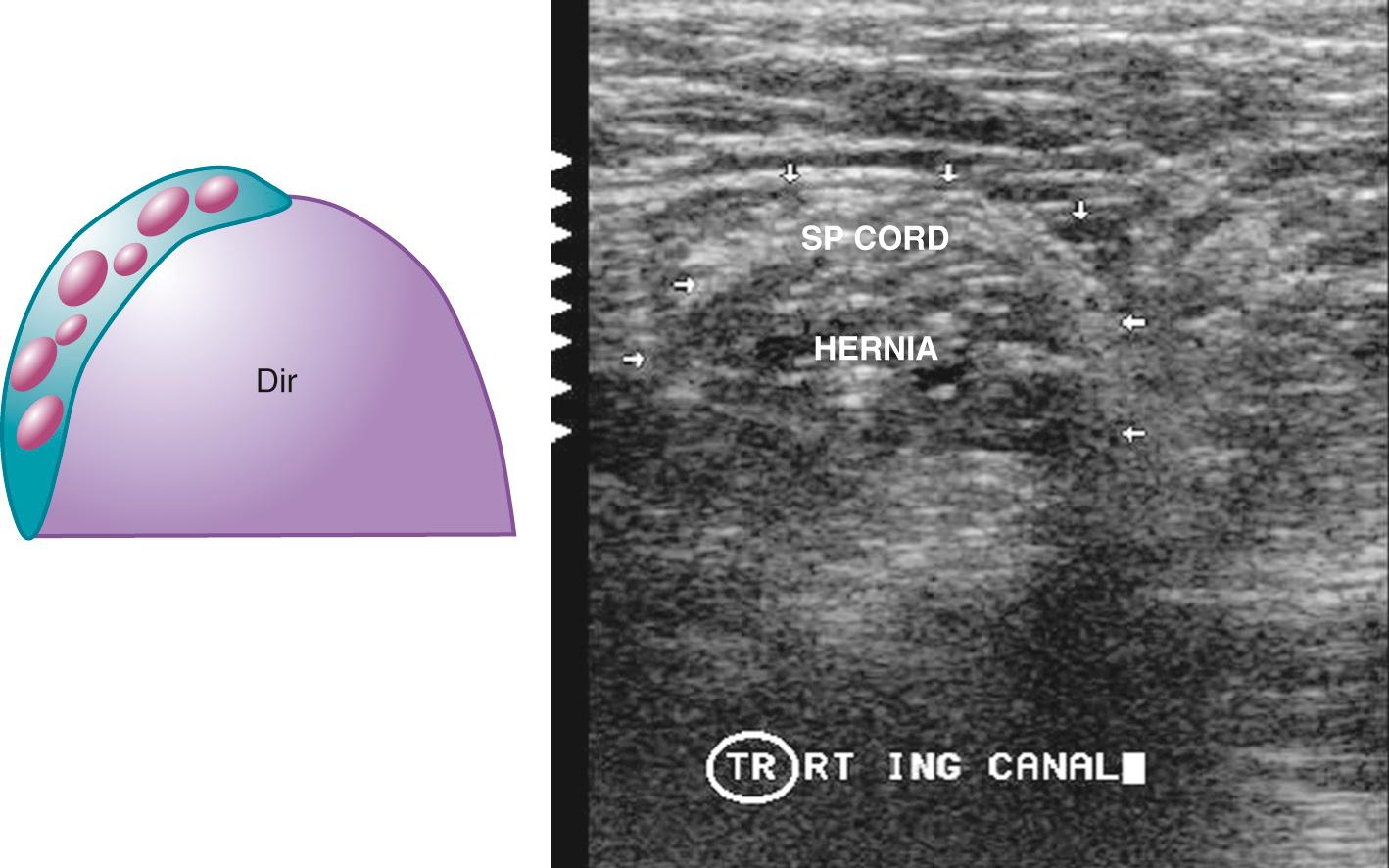
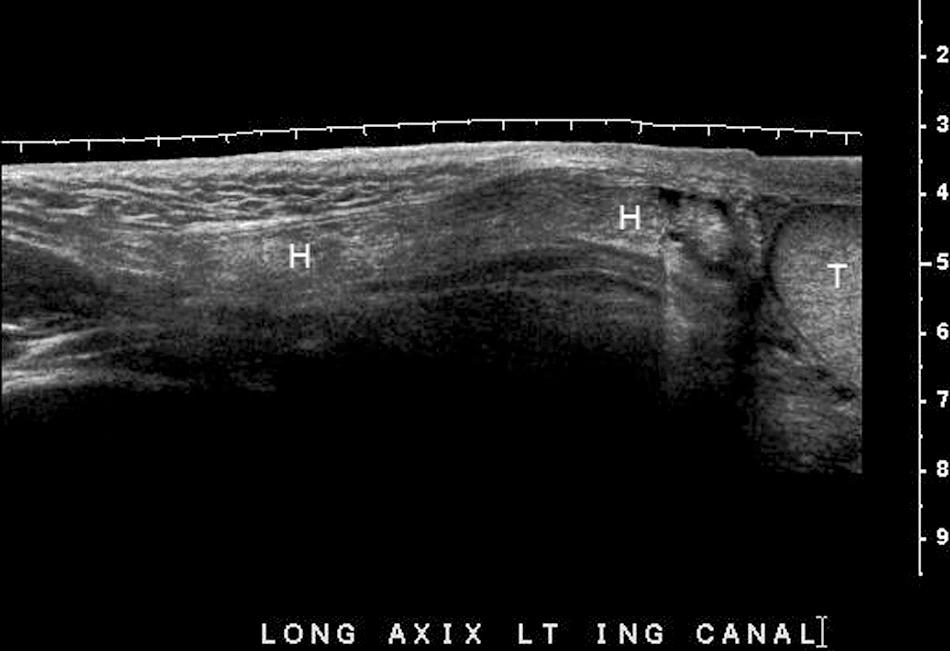
Become a Clinical Tree membership for Full access and enjoy Unlimited articles
If you are a member. Log in here